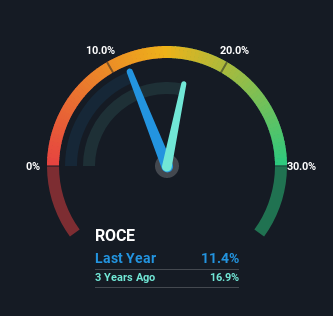- United Kingdom
- /
- Commercial Services
- /
- AIM:KINO
Kinovo (LON:KINO) Is Experiencing Growth In Returns On Capital

If you're not sure where to start when looking for the next multi-bagger, there are a few key trends you should keep an eye out for. Firstly, we'll want to see a proven return on capital employed (ROCE) that is increasing, and secondly, an expanding base of capital employed. Put simply, these types of businesses are compounding machines, meaning they are continually reinvesting their earnings at ever-higher rates of return. Speaking of which, we noticed some great changes in Kinovo's (LON:KINO) returns on capital, so let's have a look.
Return On Capital Employed (ROCE): What is it?
For those that aren't sure what ROCE is, it measures the amount of pre-tax profits a company can generate from the capital employed in its business. The formula for this calculation on Kinovo is:
Return on Capital Employed = Earnings Before Interest and Tax (EBIT) ÷ (Total Assets - Current Liabilities)
0.11 = UK£1.7m ÷ (UK£34m - UK£19m) (Based on the trailing twelve months to September 2021).
So, Kinovo has an ROCE of 11%. By itself that's a normal return on capital and it's in line with the industry's average returns of 11%.
Check out our latest analysis for Kinovo

While the past is not representative of the future, it can be helpful to know how a company has performed historically, which is why we have this chart above. If you're interested in investigating Kinovo's past further, check out this free graph of past earnings, revenue and cash flow.
The Trend Of ROCE
Kinovo has not disappointed in regards to ROCE growth. The figures show that over the last five years, returns on capital have grown by 99%. The company is now earning UK£0.1 per dollar of capital employed. In regards to capital employed, Kinovo appears to been achieving more with less, since the business is using 30% less capital to run its operation. If this trend continues, the business might be getting more efficient but it's shrinking in terms of total assets.
On a side note, we noticed that the improvement in ROCE appears to be partly fueled by an increase in current liabilities. The current liabilities has increased to 56% of total assets, so the business is now more funded by the likes of its suppliers or short-term creditors. Given it's pretty high ratio, we'd remind investors that having current liabilities at those levels can bring about some risks in certain businesses.
In Conclusion...
In a nutshell, we're pleased to see that Kinovo has been able to generate higher returns from less capital. However the stock is down a substantial 79% in the last five years so there could be other areas of the business hurting its prospects. Still, it's worth doing some further research to see if the trends will continue into the future.
If you want to continue researching Kinovo, you might be interested to know about the 5 warning signs that our analysis has discovered.
While Kinovo isn't earning the highest return, check out this free list of companies that are earning high returns on equity with solid balance sheets.
Valuation is complex, but we're here to simplify it.
Discover if Kinovo might be undervalued or overvalued with our detailed analysis, featuring fair value estimates, potential risks, dividends, insider trades, and its financial condition.
Access Free AnalysisHave feedback on this article? Concerned about the content? Get in touch with us directly. Alternatively, email editorial-team (at) simplywallst.com.
This article by Simply Wall St is general in nature. We provide commentary based on historical data and analyst forecasts only using an unbiased methodology and our articles are not intended to be financial advice. It does not constitute a recommendation to buy or sell any stock, and does not take account of your objectives, or your financial situation. We aim to bring you long-term focused analysis driven by fundamental data. Note that our analysis may not factor in the latest price-sensitive company announcements or qualitative material. Simply Wall St has no position in any stocks mentioned.
About AIM:KINO
Kinovo
Provides specialist property services to housing associations and local authorities, public buildings, industrial and commercial, and education and private sectors in the United Kingdom.
Undervalued moderate.
Market Insights
Community Narratives




